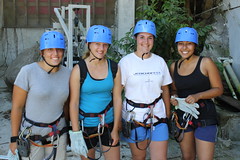The returning Spring 2009 Guatemala Cross-cultural group shared reflections and adventures from their experiences in Central America in chapel on April 20. Listen to it on the EMU Podcast.
Final reflections from India
 We recently arrived back in Delhi for our final stay in India!! For the past week we’ve been in Mussoorie, once again surrounded by the beautiful Himalayas. While we were there we stayed at Woodstock, an international boarding school. It was a very peaceful and relaxing place. During our stay we did some hiking, played card games, and worked on our final papers. We left Mussoorie at night and had an absolutely unbelievable view of the city lights.
We recently arrived back in Delhi for our final stay in India!! For the past week we’ve been in Mussoorie, once again surrounded by the beautiful Himalayas. While we were there we stayed at Woodstock, an international boarding school. It was a very peaceful and relaxing place. During our stay we did some hiking, played card games, and worked on our final papers. We left Mussoorie at night and had an absolutely unbelievable view of the city lights.
Now that we’re down to only a few days left in India, it’s hard to know how to feel. One minute I’m excited to go back to see friends and family, and to eat some American food, and the next I don’t want to leave and am trying to soak up every last bit of India that I can.
This has been an eye-opening experience and has allowed me to learn more about myself. I’ve gotten used to living a more simple way of life, and have realized that I take a lot of things for granted. I’ve learned to appreciate the little things, whether that’s sleeping on the floor of a house instead of on the street, or eating foods I hate, instead of going hungry. Overall, this trip has been a fulfilling experience that I wouldn’t trade for anything. India is a country that has so much to offer and it will be greatly missed.
-Laura Stoltzfus
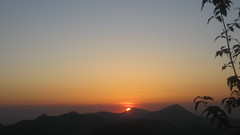 When I return home in the next few days, I will use pictures and tell stories attempting to describe how I experienced India. I will be able to sit for hours talking about the last three months to anyone that will listen. But none of this will be able to accurately depict the pictures burned into my memory: joy and despair, achievement and failure, old and new. I have been overwhelmed with emotion on this journey; let me explain how.
When I return home in the next few days, I will use pictures and tell stories attempting to describe how I experienced India. I will be able to sit for hours talking about the last three months to anyone that will listen. But none of this will be able to accurately depict the pictures burned into my memory: joy and despair, achievement and failure, old and new. I have been overwhelmed with emotion on this journey; let me explain how.
On our sightseeing adventures, many scenes have evoked strong responses. I grieved watching children beg in a train station. I felt arrogant walking out of fancy showrooms. I felt guilty swimming in a pool in the middle of a desert in Rajasthan with the potential of a drought in the next two years. I wept viewing women sort through trash for any precious leftovers from frivolous tourists. I complained about a hair in my paneer, tossing it aside, wasting a perfectly good meal while a hungry family sits outside. I was confused staring at the Akshardham temple constructed for Neelakaat, a religious figure, built 5 years ago, which cost an unimaginable amount of money. Perhaps that money could have been spent in a better way. These are a few of the emotions and images that stirred my thoughts throughout the trip.
Today, while walking the busy market streets of New Delhi, a beggar girl approached our group of guys, a typical occurrence. I was feeling generous, so I walked over to a nearby street stand and asked what 10 rupees could buy (my generosity extended to only 20 cents). He pointed to a strawberry ice pop which seemed like a nice treat on a 90 degree day. Then, I walked back to the group and handed the ice pop to her. As she walked away, she turned and smiled the brightest grin I have seen. That smile warmed my heart. One ice pop is not going to change the state of 800 million people living on two dollars a day, but that smile will remain in my memory forever. Thank you India for taking me on this crazy ride.
-Michael Harnish
Coffee
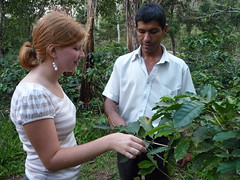 The coffee industry has had a major impact on the lives of most of Central America´s rural communities. In many cases, it has further impoverished families, creating land tenure problems and trapping small growers in a cycle of low selling prices and high production costs. However, some small coffee growers have found that by forming cooperatives, they are able to earn fairer wages for the coffee they produce.
The coffee industry has had a major impact on the lives of most of Central America´s rural communities. In many cases, it has further impoverished families, creating land tenure problems and trapping small growers in a cycle of low selling prices and high production costs. However, some small coffee growers have found that by forming cooperatives, they are able to earn fairer wages for the coffee they produce.
CECOCAFEN is one of these cooperatives, representing 2,637 small coffee growers. Santiago Dolmus, one of CECOCAFEN´s agronomists, referred to the cooperative as a “democratic” business that is tightly linked to the individual producers. Apparently, marketing and finding a fair price for coffee are the biggest struggles for coffee growers. As a large cooperative, CECOCAFEN can find markets for the coffee that Hill bring fairer wages to the farmers.
Dolmus gave four reasons for the existence of the cooperative: to sell coffee, to provide financing to farmers, to provide technical training to farmers, and to provide special programs for the cooperative´s members. In addition to finding fairer prices for its members, CECOCAFEN runs a women´s microfinancing program, a program to develop a market for high-quality coffee in Nicaragua, a tourism program in rural communities, and a youth education program.
On April 1, we visited Martin Vicente Padilla´s farm near Matagalpa, Nicaragua. Padilla is a member of the CECOCAFEN coffee cooperative and serves on the board of directors. His own coffee finca consists of about 9 acres of land that he tends using only organic farming methods. While organic coffee is his main source of income, he also grows a wide variety of fruits, precious woods, medicinal plants, and staple crops such as corn and beans. He raises chickens for eggs and meat, pigs for meat and extra income, and a cow to provide milk for his family.
While every member of the family works on the finca, they all take education very seriously. Through CECOCAFEN´s youth education program they were able to complete high school. Padilla is determined that all of his children will become professionals in some field of study, and two of them are well on their way, one studying to be a lawyer and another currently studying medicine in Venezuela.
Visiting the Padilla family´s finca reminded me again of how little I know about the origins of common products, in this case, coffee. Our visit also made me rethink my attitude toward coffee drinking. I don´t drink coffee, so I had always thought of it as a waste of resources, kind of like candy that doesn´t exactly hurt one´s body, but doesn´t really do any good, either. I never realized how many hundreds of thousands of people depend on the coffee industry to provide their daily rice and beans. Our visit also drove home the importance of buying fairly traded products. Before this trip, I viewed fair-trade products as things that were great to buy, as long as they were convinient to find and not too expensive. Now I realize that there´s a reason that most commercial coffee is cheaper: the small growers are paying the difference through low wages.
– Christina Harman
Village life in the Himalayas
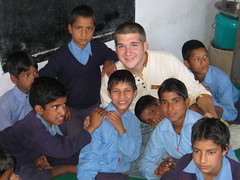 This past week was an incredible cultural experience in which we learned about village life in the Himalayas. We were connected to the villages by a local NGO called SIDH, or the Society for Integrated Development of the Himalayas. This organization helps provide a good education to rural children by giving them a solid base of knowledge and keeping them rooted in their culture. SIDH feels that this way of teaching is important because recent studies show a high percentage of the youth moving away to larger cities, which is breaking up their traditional way of life.
This past week was an incredible cultural experience in which we learned about village life in the Himalayas. We were connected to the villages by a local NGO called SIDH, or the Society for Integrated Development of the Himalayas. This organization helps provide a good education to rural children by giving them a solid base of knowledge and keeping them rooted in their culture. SIDH feels that this way of teaching is important because recent studies show a high percentage of the youth moving away to larger cities, which is breaking up their traditional way of life.
To find out more on this issue, we split into 3 groups and spent a day in 3 different villages talking to people in order to hear their stories and to see how they live. We heard perspectives from 4 areas, the school teachers, the young adults, the small children and the village leaders.
The condition in the villages is centered around a couple problems. The effects of global warming make it difficult for the famers to grow their crops and feed their animals. This is one factor influencing the young peoples’ decision to move in order to find a job. Another reason is that in recent years, people have begun to think they need a disposable income, which would be possible with a job in the city that pays in cash rather than the assets created by subsistence farming. When this happens, however, it tends to break up their traditional joint family systems into nuclear families, which is not as conducive to a successful rural lifestyle. When looking at all these issues combined, it is easy to see how such a cycle is hard to break, but this is something SIDH is working towards.
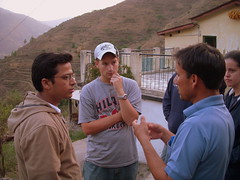 While in the villages we also had the chance to play games with the children, and ask the villagers various questions concerning marriages (arranged and love matches), leadership in the village, their daily routines, their religion, and relationships with the surrounding communities. We really enjoyed this opportunity to see the area and connect with people in a more intimate way. We feel privileged to have experienced another aspect of the diverse Indian culture!
While in the villages we also had the chance to play games with the children, and ask the villagers various questions concerning marriages (arranged and love matches), leadership in the village, their daily routines, their religion, and relationships with the surrounding communities. We really enjoyed this opportunity to see the area and connect with people in a more intimate way. We feel privileged to have experienced another aspect of the diverse Indian culture!
-Sylvia Lorisme and Anita Hoover
The astonishing beauty of India
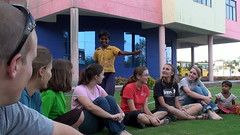 Returning for our final stay in the colorful state of Rajasthan, we arrived in the city of Udaipur, renowned for its multiple, majestic lakes. We spent some time touring local attractions such as the massive city palace and recuperating from the weary fatigue that accompanies intense travel. After a couple of days of sightseeing and shopping, we traveled up a mountain to Udaipur’s famous monsoon palace where the royal family of the Mewar dynasty would wait out the rainy season. Gazing down from the palace’s panoramic vista captivated my attention and provided me with a stunning aerial view of the entire city and its interlocking lakes. Waiting for sunset, a group of us began exploring the palace and we chanced upon a narrow staircase leading to the dank, pitch black palace cellar. When we first heard the rusty animal screeches and sounds of ominous movement we mistakenly figured the lightless catacombs were full of rats and contemplated turning back. Upon further inspection, however (and with the aid of an illuminating camera flash), we discovered a colony of bats that had taken up residency in the palace’s basement. It seems like no matter where we travel in this country, India constantly provides ceaseless surprises. Heading back to the top of the palace, we arrived just in time to watch the day end. As the sun set on the city’s mountainous backdrop and mirroring lakes, I found myself marveling once again at India’s stunning beauty and sheer magnitude as the glowing city of Udaipur stretched beyond my field of vision.
Returning for our final stay in the colorful state of Rajasthan, we arrived in the city of Udaipur, renowned for its multiple, majestic lakes. We spent some time touring local attractions such as the massive city palace and recuperating from the weary fatigue that accompanies intense travel. After a couple of days of sightseeing and shopping, we traveled up a mountain to Udaipur’s famous monsoon palace where the royal family of the Mewar dynasty would wait out the rainy season. Gazing down from the palace’s panoramic vista captivated my attention and provided me with a stunning aerial view of the entire city and its interlocking lakes. Waiting for sunset, a group of us began exploring the palace and we chanced upon a narrow staircase leading to the dank, pitch black palace cellar. When we first heard the rusty animal screeches and sounds of ominous movement we mistakenly figured the lightless catacombs were full of rats and contemplated turning back. Upon further inspection, however (and with the aid of an illuminating camera flash), we discovered a colony of bats that had taken up residency in the palace’s basement. It seems like no matter where we travel in this country, India constantly provides ceaseless surprises. Heading back to the top of the palace, we arrived just in time to watch the day end. As the sun set on the city’s mountainous backdrop and mirroring lakes, I found myself marveling once again at India’s stunning beauty and sheer magnitude as the glowing city of Udaipur stretched beyond my field of vision.
After departing Udaipur and making a quick stop to Ranakpur to visit its impressive Jain temples, we traveled back to Delhi to prepare for our final excursion up north. Upon arriving, we found out, to our great excitement, that the Dalai Lama was going to make a speech in Delhi thanking India for fifty years of generous hospitality during his long exile. 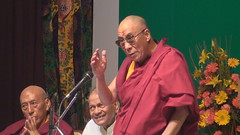 Unable to catch up with him in his headquarters in Dharamsala, we quickly jumped on the opportunity to see one of the most respected religious and political leaders in the world. As we made our way into the lecture hall I discovered that the Dalai Lama was nothing like I had expected. Making jokes and passionately expressing his gratitude to the Indian people, he seemed to emanate personal warmth and sincere concern. I find it amazing that a man confronted with as much as adversity as he has experienced over the years can remain so jovial, upbeat, and amiable. I’m delighted that we were finally able to hear him speak, and the experience will remain with me for a lifetime.
Unable to catch up with him in his headquarters in Dharamsala, we quickly jumped on the opportunity to see one of the most respected religious and political leaders in the world. As we made our way into the lecture hall I discovered that the Dalai Lama was nothing like I had expected. Making jokes and passionately expressing his gratitude to the Indian people, he seemed to emanate personal warmth and sincere concern. I find it amazing that a man confronted with as much as adversity as he has experienced over the years can remain so jovial, upbeat, and amiable. I’m delighted that we were finally able to hear him speak, and the experience will remain with me for a lifetime.
-Andrew Meade
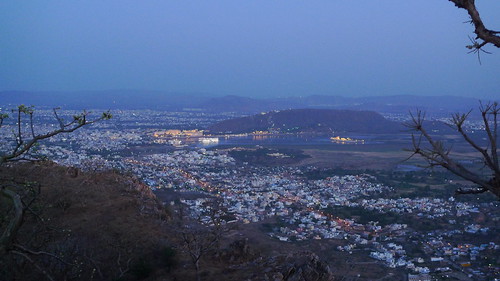 About a week ago, we arrived in Udaipur, a city in Rajasthan. Udaipur was green and lush compared to the other cities we have visited in Rajasthan. It is the city of lakes, nested in the valley of a mountainous area. It is rich with history, as we learned from the sights we visited. These included the City Palace, Lake Palace, Monsoon Palace and a Hindu Temple.
About a week ago, we arrived in Udaipur, a city in Rajasthan. Udaipur was green and lush compared to the other cities we have visited in Rajasthan. It is the city of lakes, nested in the valley of a mountainous area. It is rich with history, as we learned from the sights we visited. These included the City Palace, Lake Palace, Monsoon Palace and a Hindu Temple.
The two highlights of our trip to Udaipur, however, were the Polio Hospital and St. Matthews School that we got a chance to tour. The Polio Hospital gives free care and surgeries to thousands each year in desperate need of aid. We learned that there are 6 doctors performing countless surgeries for people who couldn’t under normal circumstances afford care. They don’t turn away anyone who needs surgery and everything is financed by donations. It was overwhelming to see all the people in need, but inspiring to hear stories of transformations made in these people’s, mostly children’s, lives. It was obvious in the faces of the patients and parents that this clinic gives hope when there otherwise wouldn’t be any.
The evening we spent at St. Matthews School showed the dedication of the minority Christian community in Udaipur. We met with the couple who rent the school and seminary and were moved by the stories they told of Christians in India. Their stories led to discussions of our own faith and how different the trials we face are. Along with these conversations, we were able to play games and sing songs with the orphan children who live at St. Matthews. Their energy and smiles were enjoyed by the whole group. Our experience was very memorable.
After our adventures in Udaipur, we traveled to Ranakpur, which was a rural setting. 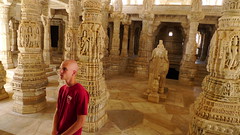 Here we experienced and visited our first Jain temple. It was a beautifully constructed temple that had over 1,000 columns. It is known as a pilgrimage site for many Jain believers. Our stay in Ranakpur was very relaxing and we enjoyed the quiet atmosphere of this area. It was a nice change from the large, crowded cities where we normally stay.
Here we experienced and visited our first Jain temple. It was a beautifully constructed temple that had over 1,000 columns. It is known as a pilgrimage site for many Jain believers. Our stay in Ranakpur was very relaxing and we enjoyed the quiet atmosphere of this area. It was a nice change from the large, crowded cities where we normally stay.
It is hard to believe that it’s almost April and that our trip is coming to an end soon!
-Allison Thurman and Kristen White
Free travel reports
Group: Peyton Erb, Cassie Leatherman, Rebecca Copeland, Yvonne Stauffer
I think we are all equally exhausted tonight. We went on a white water rafting trip today in the Pico Bonito forest just outside of La Ceiba, Honduras. First our guide had all of us stand together and say a prayer before our trip. Then they gave us tips on how to stay afloat if we were to fall off the raft. For three of us, it was the first time rafting. The guide told us all to jump off this 10-foot high rock into these swirling rapids. This was supposed to get rid of our fear of water and learn how to float. We just decided that the guide knew what he was doing and to trust him. We all jumped off one at a time. After many different feats like this one we got on the raft and started down the river. All of this lasted about 3 hours. We then rode back to La Ceiba in a big, green, army looking truck.
-Yvonne Stauffer
 “LAS BANANITAS” (Hannah Kraybill, Monika Burkholder, Jenny Blosser and Charity Strayer)
“LAS BANANITAS” (Hannah Kraybill, Monika Burkholder, Jenny Blosser and Charity Strayer)
It’s called Free Travel, and travel free we did. In eight days, Jenny, Monika, Charity and I passed through three countries, wheeled and dealed in four different currencies, pushed, shoved and bartered our way into ten buses, seven taxies, four boats, two kayaks and rested our weary bodies in five different hotel beds.
From La Ceiba, Honduras, to the Rio Dulce in Guatemala and finally down to Managua, Nicaragua to reunite with out Cross Cultural “family,” whirlwind adventure may sound like a more accurate description. But, in the midst of sun baked bus rides, shady characters, a few seedy hotels, various creepy crawlies, miscommunication, misdirection and misunderstanding, each night as we gathered for our “debriefing,” although physically exhausted, we felt spiritually energized by the adventures of our day.
Whether it was white water rafting, zip lining, a spontaneous conversation with a stranger or fellow traveler, a peaceful kayak trip, a chance encounter with a previous acquaintance, simple yet delicious food, fishing without a rod or late night talks, we molded our week, moment by moment into a priceless life lesson. Starting with flexibility, good humor and a few grin-and-bear-it moments, the result is a week abundant in laughter, beauty of all varieties and a good dose of high quality adventure.
-Hannah Kraybill
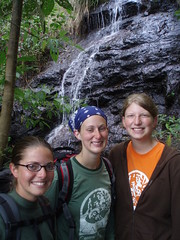 The Unsniffible (Hitch) Hikers
The Unsniffible (Hitch) Hikers
Ingrid Johnson, Allison Glick, Elisa Troyer, and Christina Harman
Our group name comes from our stench after hours of hiking and riding over dusty bumpy roads in the back of a pickup truck. We ended our first day of free travel with a starlight hitch-hike ride on the way to a little town called Gracias, in the mountains of western Honduras. We spent three days and two long nights hiking and camping in Celaque National Park, home to a very lovely cloud forest. We actually hiked for a total of about 13 hours, five of which resulted from a wrong turn on the infamous Sendero El Gallo. Looking back, we are glad for our mistake, as it allowed us to see a wider variety of flora and fauna.
After a good night’s rest in Gracias after we got back from our hiking adventure, we continued in the back of a truck to a little town called La Esperanza where we caught a bus to Tegucigalpa. We spent one night there in a pretty shady part of town after discovering that the two hostels that we had considered were either full or closed. The next day, we continued to the Honduran-Nicaraguan border, where we lost about $40 each to bad exchange rates and crooked taxi drivers. We spent that night at a hostel in Leon, and explored the city the following day, contributing to the local economy through our licuado (milkshake/smoothie drink) consumption. We stayed there for one more night, and the next morning took a bus to Managua, the capital of Nicaragua where we met up with the rest of the group in the lovely Quinta Shalom Guesthouse.
We had a lot of fun and met many interesting and very helpful people along the way. According to Ann, after this experience, we can now travel anywhere in the world!
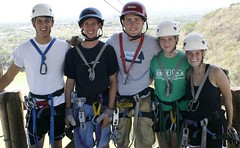 Group: Giles Eanes, Andrew Derstine, Lindsey Grosh, Amy Histand, & Aaron Yutzy
Group: Giles Eanes, Andrew Derstine, Lindsey Grosh, Amy Histand, & Aaron Yutzy
While traveling, sometimes the most random encounters, the ones that you don’t and can’t plan, end up being the most interesting bits of the journey. Our group crossed paths with a colorful host of characters throughout our travels from the Honduran island of Utila to La Ceiba, to Tegucigalpa, and finally to Managua, Nicaragua. If having uncannily good timing with buses is a sign of sharp traveling instincts, I also believe that being available and open to the people along the road, among the pigeons in the park, and in the bus seat next to you, is a mark of traveling well.
We had one such encounter during an afternoon exploration of Utila. We followed some sign for bike rentals off the street and into someone’s yard, because on Utila you’re always walking into someone’s yard to inquire about food or a place to stay or laundry service, and rented mountain bikes that had seen better days. I had to go back to the shed twice for new bikes, as the first two did not successfully make it more than a hundred meters down the road. Third time was indeed the charm, and I managed to coax the geezer of a bike down the rather uncomfortable road to Pumpkin Hill, the formerly active volcano of Utila.
While the five of us rested at the side of the road, an elderly couple crossed our path. In his thick island lilt, the gentleman told us that it was no good, that we were too young to be tired. We proceeded to talk with him about his thirty-five years on the seas as a boat hand, which included docking in Norfolk, VA many times. And then we continued on our way and they on theirs, hauling sacks of wood shavings to their farm. It felt exactly like the sort of encounter one should have on a little island. We went on our way; the bikes survived the trip back to their shed; nothing earth shattering had happened. But the chance encounters we had during the week enriched our experience and added dimension to our journey.
-Amy Histand
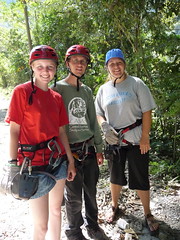 The Meanderers: Jenae Leatherman, Anna Rodgers, Michael Showalter
The Meanderers: Jenae Leatherman, Anna Rodgers, Michael Showalter
The River
Shadowed by the mountain,
Cutting through the trees.
The river roars its victory chant,
Beneath the water, life is gone.
The rain feeds its constant thirst,
The sand plows a deeper tract.
Rocks worn smooth by the river’s wrath,
Cast into shadow by the setting sun.
Whirlpools dance, spinning away,
Ripples pass, a fleeting glance.
Solid yet moving stone,
Liquid in a set path.
The river never rests,
The river always wins.
–Kiwi
As we reflected on our week, our overall trip reminded us of white water rafting the first day on Rio Cangrejal. Even though we knew our final destination and the approximate path we would take, there were always times where plans changed. There were decisions and obstacles that we encountered along the way that were unexpected, but by working together as a group we accomplished what we set out to do and had a fun, interesting experience along the way.
Mining in Honduras
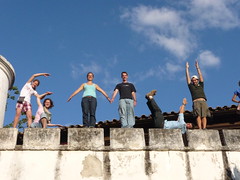 Our visit to ASONOG in Santa Rosa de Copan was very fascinating. I thought that it was very cool that we could make that connection from our speaker in the first week of orientation, Francisco Machado, to the organization that he worked with in Honduras and actually see the work they’re doing that is so dangerous to some people’s interests that he had to flee to the United States. I was appalled to hear of the pollution being produced by the mining companies, especially the cyanide pollution. Cyanide is an extremely deadly poison that they use to extract gold from the rock they mine. After the process is over they either leave the soil, but the cyanide makes is unusable, or they dump it into rivers that serve as water sources for nearby communities. It kind of upsets me. Aren’t there safer ways to extract gold than exposing so many people to such a poisonous substance? Have they no regard for human life at all? I was very glad to hear about the Civic Alliance for Democracy, a civilian organization researching the effects of cyanide on the local health and organizing local communities in protests. The Catholic Church has also gotten involved in ensuring the welfare of its people.
Our visit to ASONOG in Santa Rosa de Copan was very fascinating. I thought that it was very cool that we could make that connection from our speaker in the first week of orientation, Francisco Machado, to the organization that he worked with in Honduras and actually see the work they’re doing that is so dangerous to some people’s interests that he had to flee to the United States. I was appalled to hear of the pollution being produced by the mining companies, especially the cyanide pollution. Cyanide is an extremely deadly poison that they use to extract gold from the rock they mine. After the process is over they either leave the soil, but the cyanide makes is unusable, or they dump it into rivers that serve as water sources for nearby communities. It kind of upsets me. Aren’t there safer ways to extract gold than exposing so many people to such a poisonous substance? Have they no regard for human life at all? I was very glad to hear about the Civic Alliance for Democracy, a civilian organization researching the effects of cyanide on the local health and organizing local communities in protests. The Catholic Church has also gotten involved in ensuring the welfare of its people.
The original mining law that allowed mining companies to evict people from their homes (the new law isn’t much better) reminded me of how in the States, the road building companies used to be able to forcefully take over people’s land to build roads and expand the infrastructure. I’m not really sure how much that goes on anymore, but I’m sure whatever does happen is much different from the new mining law in which there is so much pressure to sell that you’re almost basically forced to.
Along with their work in mining, ASONOG is doing some work with community development, such as risk management and capacity building, which I was very impressed with. They even have regional boards, and they have national conferences to discuss current issues regularly. I was thinking a bit about how these municipalities only receive around 1% profit from the industry that is destroying their land and the health of the people, and it reminded me of discussions we’ve had in class about this idea of center and peripheral countries. The peripheral countries produce raw materials like food and metals, and these are sold to the center countries at a pretty cheap price. These are then processed into refined goods, and sold back to the peripheral countries for a profit. Because the peripheral countries do not provide their own refined goods, and what they can produce is of less monetary value, this creates a great inequality in the wealth of nations. Yes, it’s wonderful that Honduras can produce this raw precious metal, but when it is only sold, or extracted by the center countries, the peripheral countries are taken advantage of, and this is a prime example. The municipalities receive 1% of the profit from the industry that is polluting their soil and drinking water, displacing hundreds of people from their homes, and stripping their land of the natural resources that belong to the people. The Honduran needs to seriously reconsider the concessions it gives to these mining companies. One has to wonder if these communities would actually make more money extracting, working, and selling the gold themselves as artisans.
-Ingrid Johnson
Reports from the India/Pakistan border
 Amritsar proved to be a very interesting learning experience for me. While it wasn’t my favorite city, we saw some fascinating sights. Our first stop in the city was Jallianwala Bagh, or the site of the Amritsar Massacre. I first remember learning about this in high school when we watched the movie “Ghandi,” but to now be in the place where that event took place was very surreal for me. We entered through the one and only entrance, which was where British troops fired their arms into the innocent crowd. As we walked through the area we saw the well that many jumped into to get away from the madness. They had also preserved the walls which had many bullet marks on them. In the middle was a monument set up to commemorate the lives lost at this spot. As I walked around and soaked it all in, everything I learned became more real and more vivid to me. There is something about being there and learning about the event that made it so much better than simply reading about it in a book.
Amritsar proved to be a very interesting learning experience for me. While it wasn’t my favorite city, we saw some fascinating sights. Our first stop in the city was Jallianwala Bagh, or the site of the Amritsar Massacre. I first remember learning about this in high school when we watched the movie “Ghandi,” but to now be in the place where that event took place was very surreal for me. We entered through the one and only entrance, which was where British troops fired their arms into the innocent crowd. As we walked through the area we saw the well that many jumped into to get away from the madness. They had also preserved the walls which had many bullet marks on them. In the middle was a monument set up to commemorate the lives lost at this spot. As I walked around and soaked it all in, everything I learned became more real and more vivid to me. There is something about being there and learning about the event that made it so much better than simply reading about it in a book.
Amritsar is known for its large Sikh population, so it was only appropriate to visit the Sikh Golden Temple, known as Sri Harminder Sahib. After covering our heads and washing our hands and feet,  we entered the temple to find a holy pool with a bright golden temple in the middle. I have found that every religion in India is much different from the next and the Sikh religion is not exempt from that. The thing that makes the Sikhs unique is their belief in service. We witnessed this at lunch we ate in a building next to the temple. Thousands are served everyday from this building. We ate this meal sitting on the floor with our plates in front of us. Very swiftly and efficiently they came around and served us our food. It was quite a unique experience eating in that setting, but it gave me a very small glimpse at their firm belief in service.
we entered the temple to find a holy pool with a bright golden temple in the middle. I have found that every religion in India is much different from the next and the Sikh religion is not exempt from that. The thing that makes the Sikhs unique is their belief in service. We witnessed this at lunch we ate in a building next to the temple. Thousands are served everyday from this building. We ate this meal sitting on the floor with our plates in front of us. Very swiftly and efficiently they came around and served us our food. It was quite a unique experience eating in that setting, but it gave me a very small glimpse at their firm belief in service.
These two experiences in this one city have allowed me to further understand India’s rich and diverse history.
-Rachel Kolb
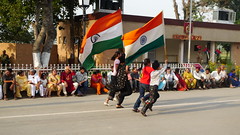 After a long and exhausting day of touring around Amritsar, I wasn’t too excited about a 30 km drive to the Wagah Border. Our journey from Dharamsala to Amritsar the previous day had several close calls on the road, so the prospect of venturing out on the “highway” again didn’t seem all that appealing. My interest peaked when our tour guide pointed out the several kilometer long line of produce trucks waiting for days to cross into Pakistan. Only 40 trucks are allowed to cross each day, so often the produce, especially tomatoes, goes bad before it crosses. This was the first visible sign of division, at least that I had noticed, between these two countries with a long history of being divided.
After a long and exhausting day of touring around Amritsar, I wasn’t too excited about a 30 km drive to the Wagah Border. Our journey from Dharamsala to Amritsar the previous day had several close calls on the road, so the prospect of venturing out on the “highway” again didn’t seem all that appealing. My interest peaked when our tour guide pointed out the several kilometer long line of produce trucks waiting for days to cross into Pakistan. Only 40 trucks are allowed to cross each day, so often the produce, especially tomatoes, goes bad before it crosses. This was the first visible sign of division, at least that I had noticed, between these two countries with a long history of being divided.
Upon exiting the bus we had to walk a little ways and be searched before arriving at the stadium where we would watch a 30 minute border ceremony. I could feel the excitement growing with each step as we approached. We entered to find ourselves in a stadium divided not only by the road running lengthwise, but also by a large wall and gate separating the Indian and Pakistani sides. On our side the BSF (Border Security Force) men, all at least 6 feet tall and in hats that made them look even taller, directed us to our seats. While we waited for the ceremony to begin, there was music and some people got up to dance.
Once the ceremony started, more BSF men came out to perform high-kicking marches, blow a horn, and do some impressive yelling as they opened the gates between the two countries. An MC also led the crowd in some Hindustan cheers to build the excitement as the two sides lowered their flags for the night. As I watched the ceremony, I gazed across the border and realized that there were significantly more people gathered on the Indian side. The difference in the lives of the people from these two countries that were once one struck me as sad in that moment. While this performance was about crossing borders, it still emphasized division. I am glad to be part of a program helping to build bridges of global understanding, rather than highlighting differences.
-Andrea Bowman
Expedition to the Himalayas
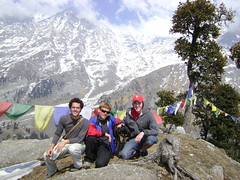 We were welcomed to the Himalayas, yet another one of India’s myriad regions and climates, by a thrown bucket of blue dye. Covered by this hooliganism that had somehow stolen through the cracked window of our car, thoughts of Delhi and Rajasthan, Kolkata and Kerala, were wiped from our minds, replaced by the snow-covered mountains that we enjoyed while our vehicle was given a preliminary hose-off.
We were welcomed to the Himalayas, yet another one of India’s myriad regions and climates, by a thrown bucket of blue dye. Covered by this hooliganism that had somehow stolen through the cracked window of our car, thoughts of Delhi and Rajasthan, Kolkata and Kerala, were wiped from our minds, replaced by the snow-covered mountains that we enjoyed while our vehicle was given a preliminary hose-off.
The day, March 11th, was Holi (pronounced: holy). We had seen signs of the festival of colors before-pink powder on the ground, strange stains on the backs of kiosk patrons-but as we arrived in Dharamsala, home of the Dalai Lama, the holiday was in full force. This meant that roving groups of young men (perhaps intoxicated on some substance, perhaps merely happy) would throw bright powder at any who strayed too near.
Despite not knowing the actual religious significance of the Holi-Day, many of the guys in the group took to the streets (roving bands of “merry” young Indian men are one of the more disconcerting things we run into; they show an obnoxious and crude interest in Western women). For a short period of time, the only colored people that we saw were Western (another disconcerting element of India; how much of what we see is Indian, and how much is a show put on to verify the Western idea of what India is… we have no way of knowing), but we quickly found Indians willing to paint us various greens, blues, reds and yellows.
Feeling festive, we embarked on a short hike to a waterfall one town over. Strangely, the water seeped into the group as if it were a drain, disappearing. On our way back, several more groups added dye to our faces, making some of us look truly frightening.
It was a good day…
-Dylan Zehr
 Early Thursday afternoon we arrived in the city of Dharamsala, which is nestled in the foothills of the Himalayas and also happens to be the home of His Holiness the Dalai Lama. Since the Chinese invasion and subsequent takeover of Tibet in the mid-20th century, Dharamsala has served as home to countless Tibetan refugees. This city has proven to be infused with more Tibetan culture and cuisine than anything else, which is a nice change after over two months of eating almost all Indian food.
Early Thursday afternoon we arrived in the city of Dharamsala, which is nestled in the foothills of the Himalayas and also happens to be the home of His Holiness the Dalai Lama. Since the Chinese invasion and subsequent takeover of Tibet in the mid-20th century, Dharamsala has served as home to countless Tibetan refugees. This city has proven to be infused with more Tibetan culture and cuisine than anything else, which is a nice change after over two months of eating almost all Indian food.
Yesterday our group took a pretty grueling trek up one of the nearby Himalayan mountains. It took us several hours of scrambling over rocks and using muscles in our legs that many of us did not know existed to finally reach the peak around lunchtime. Although many of us seriously considered turning back at various points along the way, the moment we crossed the last ridge and beheld a range of snow-capped peaks before us, we knew the hike was worth the effort. I truly cannot comprehend how thousands of Tibetan refugees have survived trekking through the Himalayas for months at a time in order to reach safety in India. I thought I might keel over and die after only a day of hiking, especially because I am not accustomed to the high altitude here (Altitude sickness is fun, by the way). After a small taste of trekking through the Himalayas, I feel as if I can more fully appreciate and admire the strength and persistence of the refugees who reside here in Dharamsala.
-Kelsey Landes
Community service reports
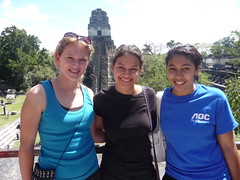 Friday, Feb. 27 was the end of language school. That day we had a Clausura in which each Spanish class did a presentation highlighting their progress from the past 8 weeks. There were a variety of presentations, all showing tremendous improvement in the students’ capabilities. That same afternoon we boarded a small plane for Flores, an island in Lake Petén Itza and stayed the night in a small hotel on the shore of the lake. Saturday morning we traveled to Tikal and enjoyed a tour and significant free time to explore the ancient pyramids in the jungle.
Friday, Feb. 27 was the end of language school. That day we had a Clausura in which each Spanish class did a presentation highlighting their progress from the past 8 weeks. There were a variety of presentations, all showing tremendous improvement in the students’ capabilities. That same afternoon we boarded a small plane for Flores, an island in Lake Petén Itza and stayed the night in a small hotel on the shore of the lake. Saturday morning we traveled to Tikal and enjoyed a tour and significant free time to explore the ancient pyramids in the jungle.
Sunday the group split up. Jared and Addie Leaman, Peyton Erb, Yvonne Stauffer, and Rachel and Ann Hershberger returned to Guatemala City. Jared and Addie were heading back to the States on Monday and the other 4 were headed to San Marcos, Guatemala, bordering Mexico for their week of community learning. The rest of us 18 students and Jim took a boat ride on the lake to visit a zoo and some water slides in the morning before heading to Semesche in Alta Vera Paz province for our community learning.
The group in San Marcos spent their week visiting a number of MCC projects there in a food security program as part of the local catholic dioceses. They were working with MCCer, Nate Howard and his local partners, Juan Pablo and Osmar. They visited two different villages, at altitudes between 8 and 9,000 feet! The first community was Nuevas Maravillas where they attended a meeting to discuss the mushroom project the community is starting. They also have flower projects. These are an attempt to increase income and food supply for the people to avoid the necessity to migrate. The produce from their projects is sold in Mexico, several KMs away.
 The next morning the group was in the school interacting with the children and Peyton was able to teach the preschool class for an hour while the teacher was not there! That same day they caught a bus back to the central town, Sibinal. There they were able to walk around the market in the morning and attend a meeting of the project treasurers from 4 communities. The second village they visited was La Vega, a community working with trout farming projects. The group attended more meetings and was able to relax by playing some soccer with the locals. After another cold night sleeping on hard boards, they woke up Friday to ice on the ground. Friday was the day of a large community celebration as well as the inauguration of about 25 houses in 5 communities built after Hurricane Stan. The group was able to share in these exciting community events and projects and learn more about what MCC and the local communities are doing in the region of San Marcos.
The next morning the group was in the school interacting with the children and Peyton was able to teach the preschool class for an hour while the teacher was not there! That same day they caught a bus back to the central town, Sibinal. There they were able to walk around the market in the morning and attend a meeting of the project treasurers from 4 communities. The second village they visited was La Vega, a community working with trout farming projects. The group attended more meetings and was able to relax by playing some soccer with the locals. After another cold night sleeping on hard boards, they woke up Friday to ice on the ground. Friday was the day of a large community celebration as well as the inauguration of about 25 houses in 5 communities built after Hurricane Stan. The group was able to share in these exciting community events and projects and learn more about what MCC and the local communities are doing in the region of San Marcos.
-Lindsey Grosh
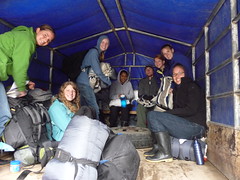 This past week in Alta Vera Paz was one of joys, struggles, and most of all growth for me. We first traveled to Semesche by cattle truck on Monday. That was interesting because it was raining and I´m not sure you could call the path we drove on a ¨road¨ at least in comparison to what we´re used to back in the states. So there was lots of jerking and bouncing, kind of like a country rollercoaster. Then we finally arrived and were welcomed with warm smiles, giggles, and stares from the community. We were divided up into our families and left to settle.
This past week in Alta Vera Paz was one of joys, struggles, and most of all growth for me. We first traveled to Semesche by cattle truck on Monday. That was interesting because it was raining and I´m not sure you could call the path we drove on a ¨road¨ at least in comparison to what we´re used to back in the states. So there was lots of jerking and bouncing, kind of like a country rollercoaster. Then we finally arrived and were welcomed with warm smiles, giggles, and stares from the community. We were divided up into our families and left to settle.
The first half of our week was spent living with our host families and enjoying communication that consisted of ¨oos¨ (good), ¨bantiox¨(thank you) and of course lots of smiles when we didn´t understand. During the day we also spent time planting trees at different houses in order to help the people of this community gain rights to their land. It was very rewarding to be filling  bags with dirt while wearing 24 feet of fabric around my waist, strung up by a string into the native dress they wear called a corte. We often walked home with dirty hands and nails waiting for the fire to start up in the evening for warmth. Those moments around the fire were some of the most meaningful to me because it was there that I felt the overwhelming feeling of being welcomed into my host family. Although it was present throughout the community, it was here that I saw the beautiful spirit of these people.
bags with dirt while wearing 24 feet of fabric around my waist, strung up by a string into the native dress they wear called a corte. We often walked home with dirty hands and nails waiting for the fire to start up in the evening for warmth. Those moments around the fire were some of the most meaningful to me because it was there that I felt the overwhelming feeling of being welcomed into my host family. Although it was present throughout the community, it was here that I saw the beautiful spirit of these people.
On Thursday we set out for a three hour hike to our second community, Sesalche. I don´t know that I have ever had to push myself so hard before. Some of our paths seemed to go up forever and there were certainly times when I wanted just stop. But when we would arrive at the top to see the view,  it was more than worth it. I have never seen anything like it. The endless mountains with the clouds draped across them… I felt like this was God´s way of giving me encouragement to keep going, and after some time we finally arrived.
it was more than worth it. I have never seen anything like it. The endless mountains with the clouds draped across them… I felt like this was God´s way of giving me encouragement to keep going, and after some time we finally arrived.
Once we had finished our first meal at Sesalche, we all headed to the church that was to be our home for the next couple nights. We immediately began pushing the benches together to create our beds and then headed off to the school for an art camp with the kids. Again this was a fun experience because most of us only knew about two words to use to communicate with the kids, but we found that we could learn a lot of new words just by drawing pictures and then pointing as the kids told us the names in K´kchi, their native language. After the art camp we discovered that the kids were not going to let us just walk back to the church. They wanted to play. So we spent the next bit of time playing ¨you´re it!¨ in K´kchi.
The next couple of days were probably some of our hardest. I felt pretty drained from the hike, lack of sleep due to hard wooden boards for beds, and I stopped eating a lot because I wasn´t feeling very good. But despite some of these conditions that we were all experiencing, we were still able to help some of the families with building cages for rabbits and also composting bens. These were a part of the Heffer Project that had been taking place in different communities. In this project families are given different things like animals with the notion that when their animals reproduce, they will then pass the gift on to five more families, and those families to others until everyone that wants to participate is included. It´s a really neat concept and helps the people of these communities take ownership of these movements rather than it being an outsider´s project. So I think we all appreciated being a part of that.
On Saturday we set out  for our three hour hike back to Semesche and even planted some trees on the way when we stopped for lunch. When we returned, we were glad to be able to sit and rest for a little bit, even if it was wooden benches that we were sitting on.
for our three hour hike back to Semesche and even planted some trees on the way when we stopped for lunch. When we returned, we were glad to be able to sit and rest for a little bit, even if it was wooden benches that we were sitting on.
The next morning we all went up to the church to attend a wedding that we were invited to. It was definitely a time to see cultural differences. For one, within this culture the men and women are separate which meant that the bride and groom did not know each other before the wedding. This probably would explain why we did not see them smile at each other. The wedding was also the church service and a baby dedication all in one. So we were there for about three hours. But it was definitely a gift to be able to be a part of this sacred tradition, and another example of how welcoming this community was to invite us to this event. After the ceremony we gathered our things and got back on the cattle truck to start our bumpy journey back to Guatemala City.
As I said before, this week of service was one of great growth for me. I got to experience a way of life that was very foreign to me. I was able to learn some new words and repeat some others more times than I would like…Bantiox. I even arrived at a point where Spanish had the comfort of a native language to me! Though it was hard and possibly the farthest from my comfort zone I have ever been, it was an experience that I, and I´m sure the rest of our group would agree, would not change for the world.
-Rebecca Copeland
